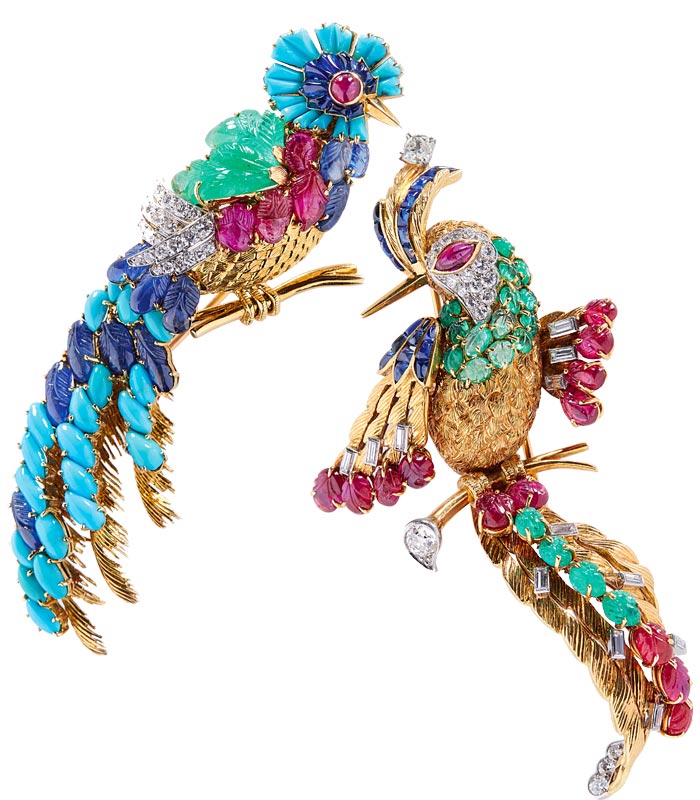Business
19 December 2019
Share
Mauboussin, from palaces to metro
Today, two events put the spotlight on the ups and downs of the jeweler Mauboussin.
Now that the Galeries Lafayette Group have become the principal shareholder of Mauboussin, well-known for making its jewelry affordable (with rings starting at €495 and wedding rings from €195) and its advertising in the metro, the exhibition on the Maharajah of Indore at the MAD (Musée des Arts Decoratifs) reminds us that this jeweler was a leading light in French haute joaillerie in the 1930s.
Mauboussin: the jewel of Art Deco
The 1920s were a decisive period in the jeweler’s history. Georges Mauboussin (who took over his uncle’s business in the 1880s) quadrupled the company’s turnover, also quadrupling the staff. Between 1928 and 1933, he staged three major exhibitions, devoted respectively to emeralds (featuring 235 jewels, including the 24-carat stone given to Josephine by Bonaparte), rubies and diamonds. These caused a distinct stir with magazines and customers, who thronged to the showcases and fairs in Rue de Choiseul. Its reputation was assured, with customers including the Maharajah of Kapurtiala, artists, writers and the Prince of Wales.
Mauboussin: the assertion of a style
Because it possessed its own workshops, the company was able to experiment and invent, filing patents for boxes, watches and so on. It designed pieces inspired by aeronautics and mechanics, created volume with baguette-cut diamonds in terraced mounts, and carved watches from rock crystal. All this brought it titles and awards at various exhibitions. It became the official jeweler to the Maharajah of Indore, for whom it mounted two pear-cut diamonds inherited from his father in a necklace: the one worn by the Maharani of Indore in Bernard Boutet de Monvel’s portrait at the MAD exhibition.
New York, Trabert & Hoeffer-Mauboussin
Mauboussin opened its NYC store on 1 October 1929, a few days before the devastating Wall Street Crash. To keep its head above water, the subsidiary signed a commercial agreement (lasting from 1936 to 1953) with New York jeweler Trabert & Hoeffer, “where you can buy jewelry without having to go to Paris,” wrote Marguerite de Cerval*. Marlène Dietrich bought two magnificent emerald bracelets, and Charlie Chaplin a bangle to console Paulette Godard when she failed to land Scarlett O’Hara. The collaboration also gave rise to the famous “Reflection” pieces, which broke new ground with geometric forms that could be arranged to their wearer’s taste.
The end of a family business
During the 1970s and 80s, the brothers Alain and Patrick Mauboussin developed sales outside France, particularly through fabulously wealthy Middle Eastern customers. In 1998, the Sultan of Brunei (who alone accounted for 80% pf the turnover) suddenly stopped placing orders. Despite the huge commercial success of the “Nadia” ring (a mix of “Nacre” – mother-of-pearl – and Diamond), Mauboussin was closed to bankruptcy. The company’s salvation appeared in the form of businessman Dominique Frémont, who in 2002 introduced a strategy to democratize its jewelry with the CEO, Alain Nemarq. The latter reduced prices, mainly by shifting production to Asia, closing boutiques like this historic example on Place Vendôme and operating without creatives. He broke another taboo the jewelry world found unforgiveable: displaying prices in advertisements. He banked on the rapid renewal of models, resorting to mass advertising on TV and in the Metro. And he broke another taboo the jewelry world found unforgiveable: running sales and displaying prices in advertisements.
Mauboussin today
This strategy combined with millions of investments in communication has paid off: “The profitability of Mauboussin that boasts 80 million in sales is impressive and continues to grow,” according to a well-informed professional. While purists may lament Mauboussin’s break with his glorious past: for the general public, this name remains synonymous with prestige.
Related articles:


















